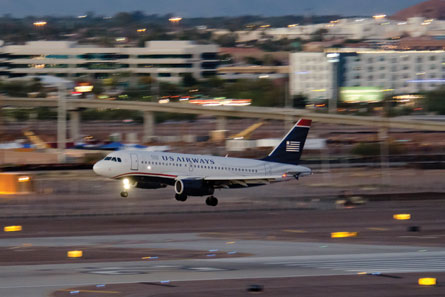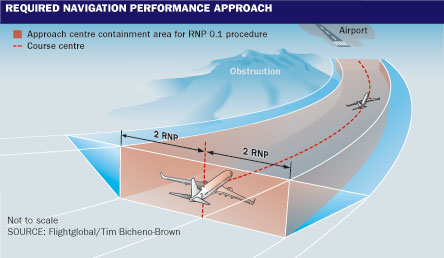US Airways flight technical operations manager Mike Davis sounds a warning as he starts a presentation on required navigation procedures: "You will hear me talk a lot about 'containment' today."
Davis is addressing pilots who are about to take an RNP checkride in an Airbus A320 full-flight simulator at US Airways' training centre in Charlotte, North Carolina. "In the RNP world, we are shrinking the RNAV GPS [area navigation global positioning system] approach corridors," he says.
RNP refers to the navigation precision required to fly the course. An RNP 0.3 value, for example, means the aircraft must be capable of remaining within 0.3nm (0.55km) of the centreline of the path.
US Airways pilots have been flying RNAV GPS approaches for about 10 years, says Davis. The airline's Airbus aircraft were delivered with GPS installed. RNP training has been carefully structured to focus on the differences between the GPS and the new approaches, and to treat RNP as a GPS offshoot. "The pilots already know the procedures," says Davis. "They just need to see the differences. Think of it [GPS approaches] as driving down a superhighway. You have big shoulders on each side of the road. You are in a well-equipped 'car', everything's working properly, and it's a safe operation. But with RNP, we are taking those 'shoulders' away. The car is well-equipped, everything is still working smoothly and safely - but reduced containment is the basic difference between RNAV GPS and RNP."
By the time US Airways pilots reach this point in their RNP training, they have attended a 45min ground school that includes a thorough discussion of the concepts, characteristics, procedures and language of the Federal Aviation Administration's next generation air transport (NextGen) system.
NextGen's "precision-based navigation" is an umbrella term referring to two categories of navigation procedures. The RNP category includes procedures used to operate to runways that do not have adequate ground-based navigation aids.
The RNP AR (authorisation required) category requires the highest level of navigation performance. It relies on a combination of GPS navigation and flight management computer, and its characteristic is a continuous descending turning trajectory, or radius to fix, turns in the final segment of the approach.
 |
|---|
©AirTeamImagesUS Airways expects approval to fly RNP procedures by year-end |
FIRST THING CREWS ARE TAUGHT
Davis notes that one of the first things crews are taught is to identify an RNP AR approach properly. His presentation includes the approach plate for Palm Springs, California. The FAA today refers to AR approaches as special aircraft and aircrew authorisation required (SAAAR) approaches.
"Could you actually fly this approach today?" asks Davis. The answer is no. The airline has not yet received the required FAA authorisation for its 216 Airbus A319/A320/A321s and 15 Embraer EMB-120s to fly RNP approaches, but expects to get it this year.
The approach has a radius to fix leg, which is non-existent in the world of GPS approaches. Davis defines the centrepoint for the radius as a line designed by altitude and airspeed to keep the aircraft within the containment area.
Reviewing missed-approach procedures, Davis underlines another difference between RNP and GPS approaches: the escape manoeuvre, which he says is to be used only "when things really, really go bad - for example, when you have lost all GPS, lost all ability to navigate".
Then the flightcrew goes to TOGA (take off, go around) thrust, turns off autopilot and climbs to minimum safe altitude to rise above terrain - fast.
After Davis's presentation, we board the Airbus A320 full-flight simulator to get a feel for RNP approaches. I take the left seat and will be "pilot flying", while Davis, the "pilot monitoring", switches between instructor station and right seat.
We review the "operations directions" page. Davis describes the quick-reference RNAV AR briefing page as a step-by-step "cookbook" designed by the airline for pilots who fly RNAV approaches infrequently.
Davis systematically sets up the multipurpose control display for the Palm Springs approach, considered US Airways' most challenging approach because it scythes a path through a 5,000-8,000ft terrain with a 12,700ft minimum safe altitude. The RNP value is 0.17 at descent altitude.
The Palm Springs approach has a radius to fix leg, and GPS is required. A temperature restriction applies: the procedure is not authorised below 1.67°C (35°F) or above 48.3°C for the uncompensated Baro-VNAV systems deployed by US Airways.
The Goodrich Class 3 electronic flight bag allows the user to manoeuvre easily through, and switch, pages, highlight important information on charts, note clearances, and share information with the second pilot.
Jeppesen's Airport Moving Map display depicts "own ship" position and provides solid situational awareness as we taxi to the departure runway. We climb out quickly, and no sooner have we levelled off than Davis positions the aircraft on approach to Palm Springs. The co-pilot stresses that no modifications of lateral path are allowed.
 |
|---|
WARNING SYSTEM
To ensure the aircraft remains in the containment area, Davis will call out if the aircraft exceeds a half-dot lateral precision navigation, and will call "go around" if a three-quarters dot indication appears. The aircraft's emergency ground proximity warning system will signal any altitude deviation.
The flight is at Yocul waypoint when the display's green "GPS primary" designation is replaced by an amber "GPS primary lost" message. Here training kicks in - pilots are to perform a missed approach in the event of a GPS primary loss, navigation accuracy downgrade or vertical deviation, or if the runway is in sight at the missed approach point.
In previous times, a flightcrew would use only TOGA for a missed approach, says Davis. "When TOGA was designed, every approach was 'straight in', every missed approach was 'straight out'," he says.
Not so with RNP, where TOGA NAV must be used. "Engaging NAV is critical to stay in the containment area," says Davis.
He points out that the aircraft is perfectly capable of navigating on one GPS system, "but we cannot continue the [Palm Springs] approach, so we stop the descent, remain in NAV and execute a missed approach to the holding pattern".
The biggest challenge in executing RNP approaches is not to exceed the maximum speed on the radius to fix leg during a missed approach executed between the final approach fix and decision altitude, says US Airways' director of technologies, Ron Thomas. If airspeed is too high on a turn, the aircraft will fly out of the containment area.
In the real world, US Airways pilots on the RNP simulator checkride have to fly at least two RNP AR approaches with radius to fix legs, one to a landing and one to a missed approach, both as the "pilot flying" and as the "pilot monitoring".
The airline has included RNP in qualification training since March 2009 and in continuing qualification training since May 2009.
All 2,760 Airbus and Embraer 190 pilots have completed RNP training, says Thomas, and most report a smooth transition to NextGen RNP.
Source: Flight International
















